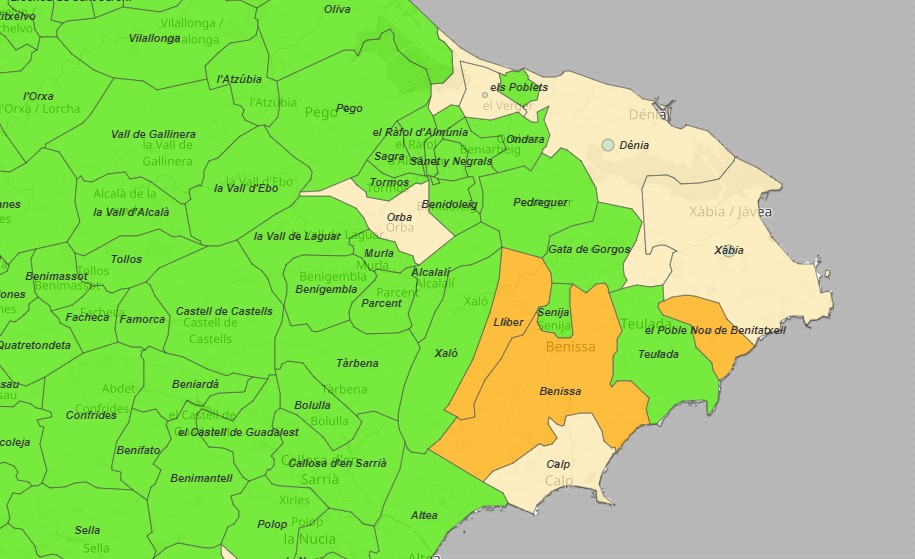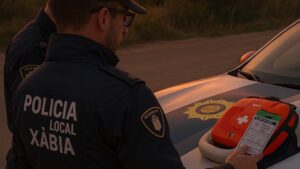VIRUS UPDATE: Xàbia edges back towards ‘medium risk’ level
Across the Comunidad Valenciana, the general trend is up with an average of 11% increase in infections compared to two weeks ago across the health departments.

Friday 28th May 2021 – Compiled by MIKE SMITH
The total number of positive coronavirus cases detected by PCR test in Xàbia has risen by three to 1,478, according to the latest update from the regional health ministry. And with 14 cases detected in the past 14 days, the municipality’s 14-day IA rate, a measure of the speed at which the virus moves through the population, has risen again to 49.97 cases per 100,000 inhabitants, the highest it has been since April 28th, which means that the town just about remains in the ‘Low Risk’ category. Some good new is that there have been no new deaths in Xàbia since late March and the number for remains at 12.
In the Marina Alta region, there have been 8 new positive cases detected in the past 14 days whilst the total number of positive cases since the pandemic began has been confirmed as 10,106, a rise of 12. The region’s 14-day IA rate has risen slightly to to 31.65 cases per 100,000 inhabitants and the region remains in the ‘Low Risk’ category. There have been no new deaths since the last update and the region’s toll remains 203.
With an IA-rate of 120.48, Llíber is the municipality in the Marina Alta with the highest potential infection spread and remains in the ‘Medium Risk’ level along with El Poble Nou de Benitatxell (67.39) and Benissa (62.01). Six municipalities are currently in the ‘Low Risk’ category: Xàbia (49.97), Orba (44.80), El Vergel (42.47), Dénia (35.02), Xaló (34.87) and Calp (25.72), whilst the rest of the municipalities in the region are at the ‘New Normal’ level, with 19 of them – mostly in the inland valleys – showing no infection spread over the last 14 days.
Spain
Spain’s 14-day IA rate is 125.02 cases per 100,000 inhabitants and the country remains in the ‘Medium Risk’ category. The rate has dropped by around 25% in the past two weeks, whilst the Positivity Rate, the measure of how many coronavirus tests return positive, is 4.95%; a value of 5% or less indicates that transmission of the virus is more or less under control.
Across the autonomous regions, the País Vasco still leads the way with a 14-day IA rate of 201.67 but it has been steadily decreasing over the past week and the region finally drops into the ‘Medium Risk’ category. The autonomous city Ceuta (20.19) remains the region with the lowest infection rate in Spain. The Comunidad Valenciana (32.54) remains at the ‘Low Risk’ level, although the infection rate has risen slightly and the region now finds itself at similar levels to two weeks ago.
Infection spread has continued dropped in the majority of Spain’s autonomous regions and enclaves; after a succession of rises in its data, Murcia experienced a small drop in the last update but its rate remains some 16% above its level of two weeks ago.
The newspaper El Pais has reported that experts are divided on whether the mandatory wearing of facemasks in Spain should end, with some arguing that the infection spread rates need to be lower and vaccination coverage needs to be higher. The European Centre for Disease Prevention and Control (ECDC) has already suggested that mask use can be reduced for those who are vaccinated, whilst countries such as Israel and the USA, which both have higher vaccination rates, have lifted the requirement to wear masks in the street. The Madrid Public Health Association has said that the wearing of facemasks at all times “is absurd, because it obliges the use of masks in environments of low or zero risk, such as in the countryside or the streets of our towns and villages” but Daniel López-Acuña, former WHO Director of Emergencies, said that “we shouldn’t even be considering relaxing face mask rules while the incidence is still very high in a lot of Spain”.
Vaccination (27.05.21)
Spain has administered 25,745,178 doses of vaccine, which is 94.6% of those which it has already received. A total of 8,614,678 people have completed the recommended course, which is 21.5% of the total of the population which is to be vaccinated (40,129,822).
According to the latest data provided by the health authorities, 94.3% of people aged 60 and over in Spain have received at least one dose, with 56.3% having completed the recommended course.
The Comunidad Valenciana has administered 2,632,543 doses of vaccine, which is 91.5% of the total which it has received. A total of 8881,810 people have completed the recommended course, which 18.8% of the population which is to be vaccinated (4,289,305).
According to the latest data provided by the health authorities, 94.7% of people aged 60 and over in the Comunidad Valenciana have received at least one dose, with 55.2% having completed the recommended course.
The newspaper El País has reported that the majority of essential workers under the age of 60 who were given the AstraZeneca vaccine as a first dose have opted to continue with the same type for their second dose, despite being offered the Pfizer vaccine as an alternative and being required to sign a consent form. The AZ vaccine has been linked with rare cases of blood clotting
LINKS
- Actualización nº 384. Enfermedad por el coronavirus (COVID-19). 27.05.2021
- GIV COVID-19 Gestión integral de la vacunación COVID-19
- COVID-19 C. Valenciana: Monitoratge de la situació



